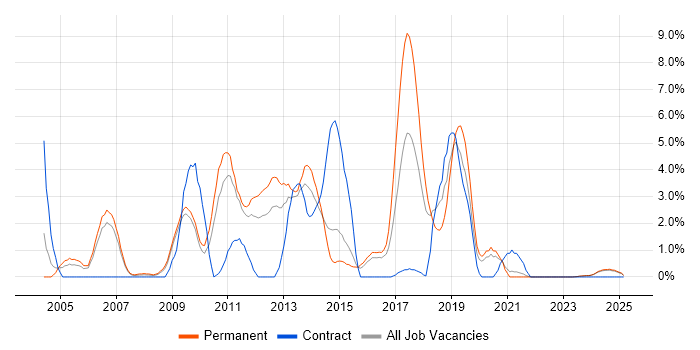Transact-SQL
East Midlands > Lincolnshire
The table below provides summary statistics and salary benchmarking for jobs advertised in Lincolnshire requiring T-SQL skills. It covers permanent job vacancies from the 6 months leading up to 25 December 2025, with comparisons to the same periods in the previous two years.
|
|
6 months to
25 Dec 2025 |
Same period 2024 |
Same period 2023 |
| Rank |
46 |
27 |
- |
| Rank change year-on-year |
-19 |
- |
- |
| Permanent jobs citing T-SQL |
1 |
3 |
0 |
| As % of all permanent jobs in Lincolnshire |
0.26% |
1.39% |
- |
| As % of the Programming Languages category |
1.61% |
11.54% |
- |
| Number of salaries quoted |
1 |
1 |
0 |
| 10th Percentile |
- |
- |
- |
| 25th Percentile |
£47,500 |
- |
- |
| Median annual salary (50th Percentile) |
£50,000 |
£50,000 |
- |
| 75th Percentile |
£52,500 |
- |
- |
| 90th Percentile |
- |
- |
- |
| East Midlands median annual salary |
£50,000 |
£47,500 |
£49,995 |
| % change year-on-year |
+5.26% |
-4.99% |
-0.01% |
T-SQL falls under the Programming Languages category. For comparison with the information above, the following table provides summary statistics for all permanent job vacancies requiring coding skills in Lincolnshire.
| Permanent vacancies with a requirement for coding skills |
62 |
26 |
21 |
| As % of all permanent jobs advertised in Lincolnshire |
16.19% |
12.04% |
16.80% |
| Number of salaries quoted |
52 |
19 |
18 |
| 10th Percentile |
£26,000 |
£39,650 |
£31,250 |
| 25th Percentile |
£29,000 |
£45,188 |
£38,125 |
| Median annual salary (50th Percentile) |
£30,000 |
£47,683 |
£45,000 |
| Median % change year-on-year |
-37.08% |
+5.96% |
-18.18% |
| 75th Percentile |
£42,500 |
£60,625 |
£57,500 |
| 90th Percentile |
£47,500 |
£64,500 |
£58,250 |
| East Midlands median annual salary |
£45,390 |
£50,000 |
£53,500 |
| % change year-on-year |
-9.22% |
-6.54% |
-0.93% |
T-SQL
Job Vacancy Trend in Lincolnshire
Historical trend showing the proportion of permanent IT job postings citing T-SQL relative to all permanent IT jobs advertised in Lincolnshire.
T-SQL
Salary Trend in Lincolnshire
Salary distribution trend for jobs in Lincolnshire citing T-SQL.
T-SQL
Co-Occurring Skills & Capabilities in Lincolnshire by Category
The following tables expand on the one above by listing co-occurrences grouped by category. They cover the same employment type, locality and period, with up to 20 co-occurrences shown in each category:


